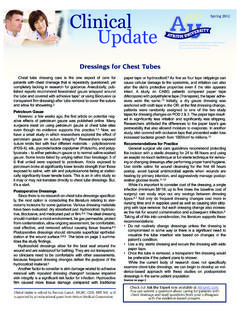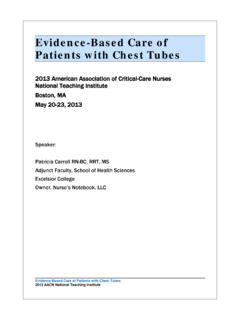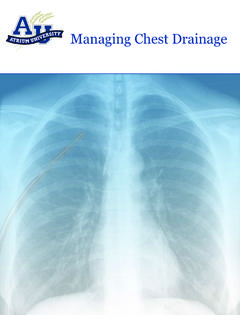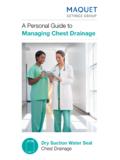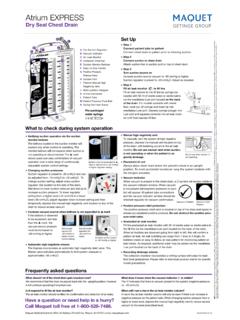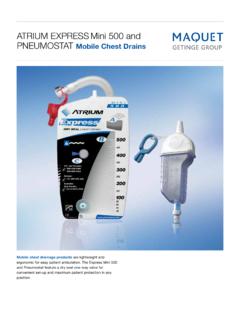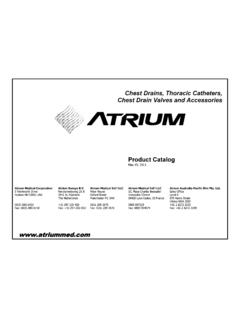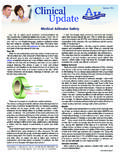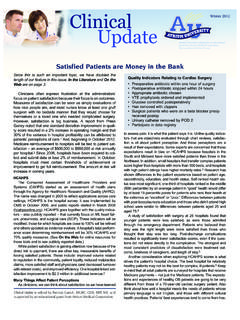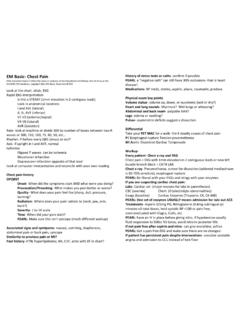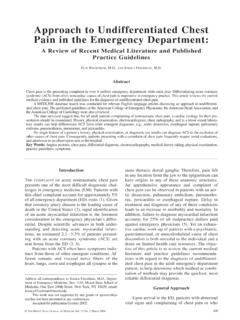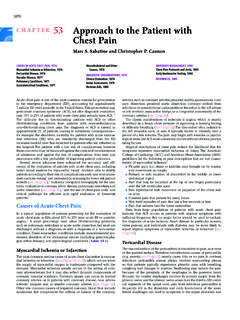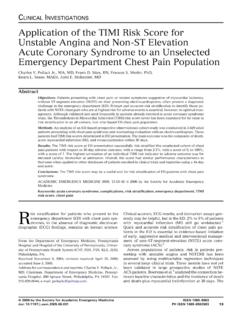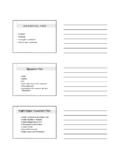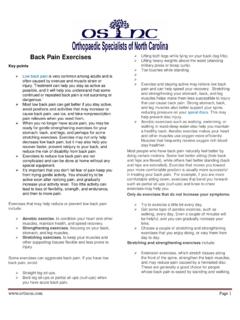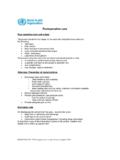Transcription of Nurses Removing Chest Tubes - Atrium Med
1 Over the past 20 years, the bedside RN s role in Chest tuberemoval has been revisited since Kinney s initial research in review covers issues relating to scope of practice, nurse prac-tice acts, and the literature on Chest tube of PracticeA scope of practice is the legal definition of a licensed profes-sion set out by a state s practice act. A dynamic of professionalpractice silos has persisted today, despite the significant changesin healthcare delivery and the emergence of collaborative practicein virtually all settings. This has led to turf wars when one profes-sion goes to the legislature to modify its practice act as othersclaim unique ownership of certain National Council of State Boards of Nursing (NCSBN) withregulatory boards from occupational therapy, pharmacy, physicaltherapy, and medicine have called for a different view of scope ofpractice to meet the goals of health reform: improved access tocare and reduced costs while maintaining safety.
2 Consumer advo-cacy groups support this ,3 Most Nurses are familiar with thescope of practice debates in their own states over whether APRN scan practice independently and prescribe controlled substances. Practice regulation is essential to protect the public and offer away to discipline those who do not comply with standards. Practiceacts should, first and foremost, focus on safe practice and publicprotection; they should not be used for professional self-interest orcreate unnecessary barriers to patient ,3 State legislatures ultimately have the responsibility to set pro-fessional scope of practice. The stakeholders recommendconsidering these critical factors2: Historical basis for the profession and its evolution Relationship of education and training to scope of practice Evidence of how a change in practice benefits the public Ability of the regulatory agency to manage any modificationsNursing PracticeEach state has a nurse Practice Act.
3 While there are compactsthat allow Nurses to practice across state lines, such as in trans-port and telehealth, the nurse is still responsible for following thepractice act of the state in which he or she practices. The American Nurses Association describes the factors affect-ing scope and standards of nursing practice for both RNs determining what a nurse is permitted to do, firstis state law and regulation. None of the other elements can over-ride the law. Next is the policies and procedures(P&P) where thenurse is practicing. While Nurses are required to follow institution-al P&P, those cannot disregard the nurse Practice Nurses must honestly assess theirpersonal knowledge, experience, and skills and not carry out atask or procedure for which they are not prepared.
4 Finally, a nurseshould consider liability and risk managementconcerns. Nurseswho do not follow regulations or P&P and do things without prop-er education will not be covered by their malpractice insurance andmake themselves a target for Tube RemovalThe first data on Chest tube removal by Nurses came in anAACN surveyin 1993. With regard to the facility policy, 80% ofRNs did not remove Chest Tubes . Of those that did, 14% were onlymediastinal, 28% only pleural and 57% removed both. RNsremoved Tubes from patients with cardiac surgery (12%), thoracicsurgery (7%), thoracic trauma (5%) and other conditions (5%).Only 44% of Nurses had a written standard P&P. Four years later, a more robust survey was done. This timefewer Nurses said RNs could remove Chest Tubes 17% (n=90)versus 20% (n=127).
5 About 52% of the removal group reportedremoving both mediastinal and pleural Tubes , 24% only mediasti-nal, and 24% only pleural Tubes . The number of facilities withwritten P&P increased to 77%. The RNs permitted to removechest Tubes included staff Nurses (25%), a core group of speciallytrained Nurses (53%), CNSes (10%), and APRN (19%).(Respondents could choose more than one). Six percent had nospecial training to remove Tubes , while 31% had classroom lec-ture; 52% had competency testing, and 87% had preceptedexperience. (Again, could choose more than one).In a 1995 survey of pain management during Chest tuberemoval, 11% of RNs removed their patients Chest Tubes ; APRNs removed the Tubes . Classroom and clinicalinstruction together were required in 40% of organizations andclinical teaching alone in 34%.
6 Just 7% required competency test-ing and 34% had written P& were significantly morelikely to receive pain medication before tube removal when nurs-es removed the tube compared with physician removal. Three other studies5-7described experience with RNs remov-ing Chest Tubes ; two instituted the practice specifically to managepatient pain more ,7 All projects were successful, reduc-ing patient pain with no post-removal RNs Permitted to Remove Tubes ?The evidence shows that bedside RNs with additional trainingcan safely and efficiently remove Chest Tubes . However, despitethe goals of coordinating scope of practice, state nursing practice differs from medical practice. Nursing practice is a right grantedby a state, described by the nurse Practice Act.
7 These acts are notlaundry lists of tasks and procedures. They are broad statementssuch as The delivery of health care services which requireassessment, diagnosis, planning, intervention and such acts require substantial specialized judgmentand skill base on knowledge and application of the principles ofbiological, physical and social sciences. 8 The practice actsempower the board of nursing to write rules and regulations andissue opinions that relate the scope of practice to specific states have addressed Chest tube removal, based on aNurses Removing Chest TubesClinical Update is edited by Patricia Carroll, MS, RN-BC, CEN, RRT, andsupported by an educational grant from Atrium Medical 2014 Continued on page 2 Fall 2014In the LiteratureWho s at Risk for C.
8 Difficile?The current issue of AACN Advanced Critical Carefeatures a studydescribing how Nurses developed a C. difficilerisk assessment tool. Theauthors provide a comprehensive review of the literature, includinganalysis of other scoring tools and a detailed description of how theychose the items on their assessment. They believe that by using the toolto identify at-risk patients, clinicians can provide prophylactic treatment,promptly isolate patients, restrict antibiotic use, and limit testing of low-risk patients. Source: Smith, LA et al.: Development and validation of a Clostridium difficile riskassessment tool. AACN Advanced Critical Care2014;25(4):334-346. PubMed CitationAre Authors Really Writing?In recent years, there has been a careful examination of whether namedauthors of studies in the medical literature actually did the research andwrote the paper.
9 The first examination of inappropriate authorship in nurs-ing journals is in the current issue of the Journal of Nursing looked at articles published in 10 nursing journals and thefinal dataset contained 422 articles. Authors did not meet published criteriafor authorship in 42% of articles. There were unnamed contributors known as ghostwriters in 28%. The researchers contacted correspondingauthors to identify reasons for this practice. Their answers are : Kennedy, MS et al.: Honorary and ghost authorship in nursing publica-tions. Journal of Nursing Scholarship2014;46(6):416-422. PubMed CitationCan You Get Good Lab Samples When Starting an IV?It s a debate revisited often: is the quality of blood samples collectedthrough an IV catheter acceptable for laboratory tests, or do patientsrequire dedicated venipuncture?
10 A study in the Journal of EmergencyNursingexamined 9000 blood draws to try to answer the question. Eachsample was examined by spectrophotometry. Blood collected at an IVstart had a hemolysis rate, when collected from existing vas-cular access and with venipuncture and a steel needle. Thesevalues compare favorably with a laboratory benchmark of 2%.Source: Dietrich H: One poke or two: can intravenous catheter provide an accept-able blood sample? A data set presentation, review of previous data sets anddiscussion. Journal of Emergency Nursing2014;40(6):575-578. PubMed CitationNational Council for State Boards of NursingThe NCSBN is the key resource for information aboutNurse Practice Acts, laws, and regulations relating tonurse licensure.
